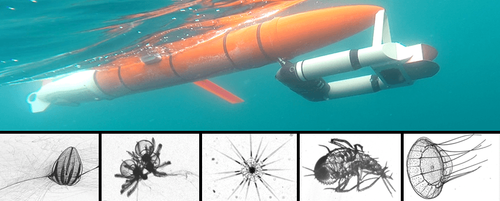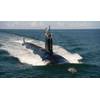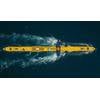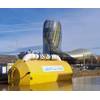New Robot Can Sense Plankton Optically and Acoustically

Zooglider (top) with a selection of zooplankton imagery the robot has captured. Top photo: Benjamin Whitmore
A team of biological and physical oceanographers and engineers have modified a common physical oceanography instrument to be able to image zooplankton as it glides through the ocean.
The robot, a first-of-its-kind sensing instrument dubbed Zooglider by Mark Ohman, a biological oceanographer at Scripps Institution of Oceanography at the University of California San Diego, uses as its platform a Scripps-developed glider known as Spray. Ohman and Scripps instrument developers outfitted the torpedo-shaped Spray gliders with a camera (called Zoocam) and a device researchers call Zonar that gathers acoustic data about zooplankton – free-drifting microscopic marine animals – in the manner of a sonar instrument.
Zooglider can acquire images of zooplankton every five centimeters to depths of 400 meters or more as it channels seawater into an onboard sampling tunnel. The new instrument represents a breakthrough in that it enables observations of microscopic life in its habitat and provides information about that life in spatial context. This advances scientists’ ability to acquire quantitative data about microscopic life within defined areas, a fundamental pursuit of biological oceanographers who study how marine organisms interact with and are influenced by the physics and chemistry of their surroundings.
“Nearly all major processes in the ocean – carbon cycling, fisheries production, harmful algal blooms, ocean acidification, deoxygenation – are linked directly to the free-drifting animals of the open sea, the zooplankton,” Ohman said. “This is our first window on their world through a completely autonomous vehicle. We're excited by the new opportunities Zooglider offers to visualize and understand these organisms, unperturbed in their natural environment.”
The data collected by Zooglider will provide knowledge about zooplankton dynamics that yields indirect information about the phytoplankton upon which zooplankton feed and about the organisms that feed on zooplankton. Zooglider also promises a priceless view of how marine life is responding to climate change.
Physical oceanographers and engineers led by Scripps’ Russ Davis developed the Spray glider beginning in the late 1990s. The 2-meter-long robot, which can be programmed from a cell phone, has been used to detect and monitor El Niño conditions off California, oil spills in the Gulf of Mexico, and currents in the Solomon Sea. Spray gliders are programmed to run along transects, diving and resurfacing in seesaw fashion as their buoyancy is manipulated by internal bladders. While at the surface, the gliders transmit data back to researchers.
Ohman, Davis, development engineer Jeff Sherman and others added an optical sensor package and sonar system to Zooglider. The authors said they chose Spray as a platform over other types of marine instruments because of its ability to minimize power consumption and stay in the ocean for periods of 50 days or more with the addition of more complex sensors. Also, its design causes the least amount of disruption to the microscopic communities it observes.
“Mark [Ohman] had a great idea to carry a highly magnified camera into the upper ocean on gliders to observe the zooplankton and Jeff [Sherman] and I had a great time designing the long focal length Zoocam and mounting it on a Spray glider to make Zooglider,” Davis said. “Even more gratifying was to see how new facts of zooplankton behavior were deduced from its data."
Co-author Jeffrey Ellen from UC San Diego’s Jacobs School of Engineering is creating methods by which Zooglider image data can be analyzed through machine learning. Other contributors include Kyle Grindley, Benjamin Whitmore, and Catherine Nickels of Scripps.
Development of Zooglider was supported by the Gordon and Betty Moore Foundation.














 August 2025
August 2025



